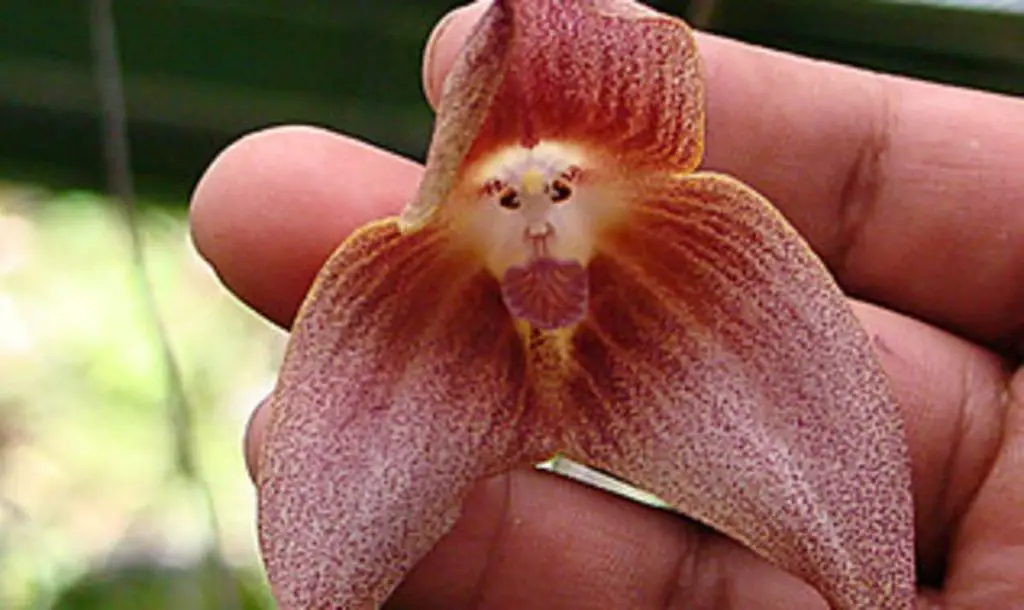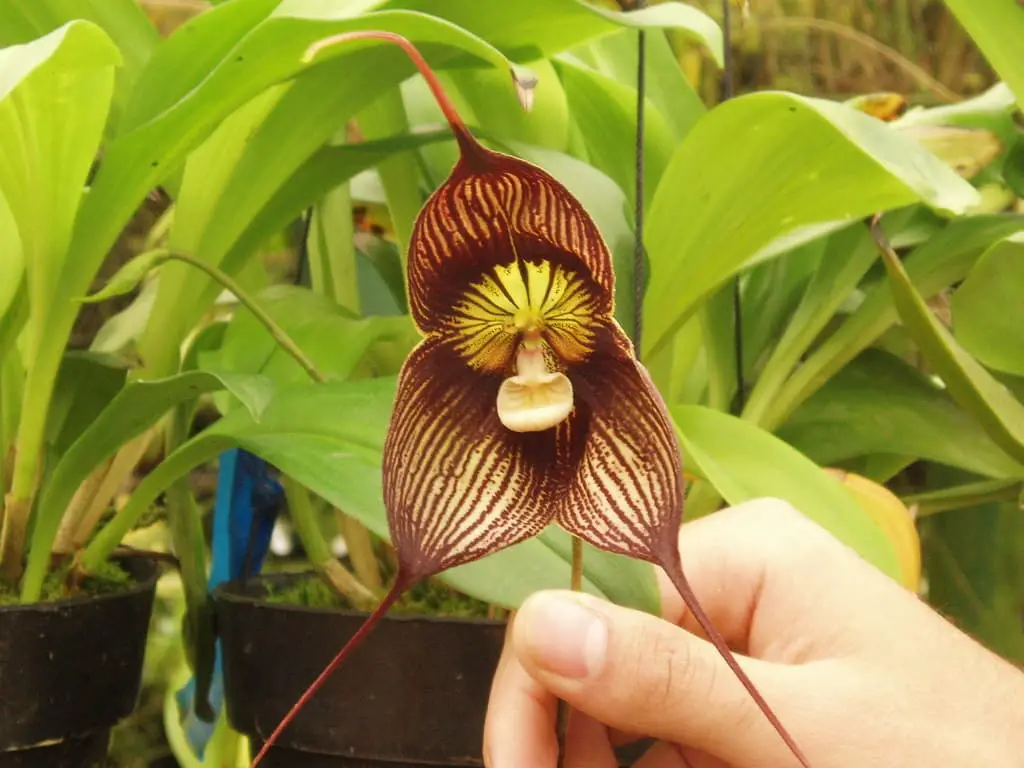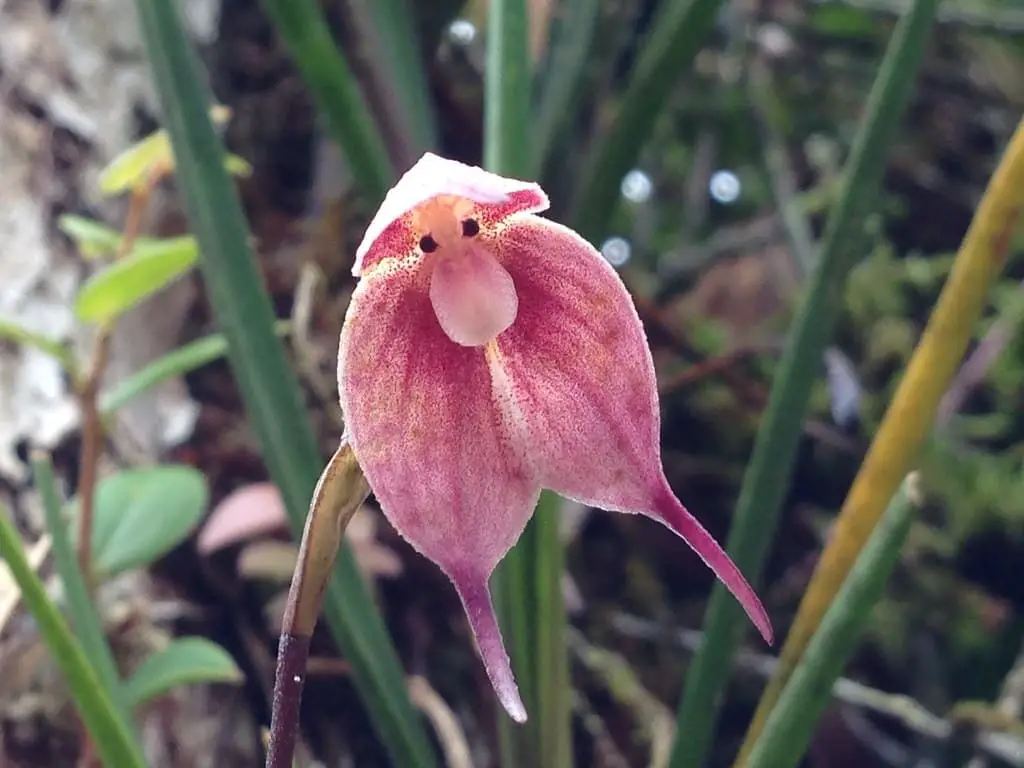You’ve probably heard of a monkey-faced orchid and aren’t sure if someone was just pulling your leg, or if they are in fact, “a thing”.
Monkey-faced orchids are real and they’re denominated Dracula orchids, first described by Carlyle Leur in the publication Selbyana in 1978. The curious thing is that neither the Transylvanian vampire Dracula nor the forest monkeys are what inspired its name. Dracula orchids come from the Latin, draco, which means dragon.
To care for Dracula orchids (or monkey-faced orchids), you need to provide low light conditions, around 1,200 fc to 2,000 fc, a humidity range of above 70% preferably between 75-80%. They prefer cool growing environments between 50 to 77F (10 to 25 C) . Dracula orchids hardly like any fertilizer, but grow with daily waterings, and lots of cool air movement.
Where we might envision monkeys with little eyes and funny-looking nose, the people who first named them thought of dragons. Even though we seem to think they look like dragons or monkeys, they have been trying to imitate mushrooms.
In any case, Dracula orchids are stunning and inspire curiosity.
The way their petals and sepals open up imitate little faces, hence their nickname cara de mono (monkey face). The most “monkey-face-resembling” orchid is the species Dracula simia.

ENVIRONMENT AND NATURAL HABITAT
These cool-growing orchids fit into a subtribe of Pleurothallidinae orchids, a tribe shared with Masdevallias and Pleurothallis. Dracula orchids are divided into 120 species and live in the Americas, from southeastern Mexico (Chiapas) all the way down to the northern tip of Peru. Their main concentration and diversity are found in Ecuador and Columbia, along the mountain ranges.
Dracula orchids are not tropical rainforest orchids—much to the contrary.
These orchids live in the tops of mountains and cliffs, thriving in the middle and upper altitudes of 1800 – 2200 m (6,000 – 7,260 ft), where the humidity is a constant high and the temperatures, extremely cooler. The temperature in these cloud forest mountain ranges from intermediate to cool (50 to 58 F at night, or 10 to 14 C).
In these areas, which are described as cloud forests, the sun is a rarity, shared by few. What lurks around most of the day are clouds, which dissipate the sun’s rays, making light hard to come by. This means that when growing indoors, these orchids will require low light conditions, 1,200 fc to 2,000 fc. These ranges are less than a Phalaenopsis.
The thick clouds at the tops of these mountain ranges make the humidity linger on forever, which means humidity is extremely high. This part was one the hardest for me to manage in my home office since even with my humidifier, I can’t get the humidity much higher than 44%. The first hardest was temperatures, but I’ll get to that later.
To keep a Dracula orchid, I had to make a special terrarium, or an orchidarium, with a humidity gauge, mister, fan, and a cool-evaporative humidifier (Affiliate Link) . I’m writing an article about how I built that. As soon as I’m finished, I’ll link it here.
. I’m writing an article about how I built that. As soon as I’m finished, I’ll link it here.
This is why I have to emphasize that Draculas are not beginner orchids, because of the setup. Once you have that specific setup, they are increasingly easy to grow, which brings me to my next topic, Dracula care guides.
TEMPERATURE FOR DRACULA ORCHIDS
To imitate these Andes Cloud Forest orchid conditions, you need to focus on temperature and humidity. The rest can be easily remedied with “homemade” solutions.
Draculas prefer cool temperatures, ranging from a maximum of 77 to 80 F (25 to 27 C) during the day, and 15 degrees drop at night. They will grow better with a cooler temperature during the day, and I’ve found that if the temperatures are too high, the flowers will wilt soon after opening.
With these extensive drops in nighttime temperature, I had to find a way to not raise my electric bill astronomically, and still not sleep with three covers on my bed. First, I moved the terrarium out of my home office, which during the day can get quite hot. I know I’ve said it before, but Draculas do not do well in temperatures over 77 F. 80 F is really pushing the bar.
I could either place my terrarium in my basement which would have the perfect temperatures for this, but I’m never down there. So I carried my terrarium to my bedroom and bought a cool-mist evaporative humidifier.
It’s not great for bigger terrariums, but for mine, it does very well because I the cool mist brings the daytime temperature down and I don’t have to worry about freezing when I sleep.
HUMIDITY REQUIREMENTS FOR DRACULA ORCHIDS
Humidity:
As you’ve already guessed, this is the second part that would be worrisome when buying these orchids. Draculas love the misty clouds and humidity requirements are anything above 80%. I’ve read 70 to 75% also, but I find that the more, the merrier. Killing 2 birds with 1 stone, I solved that problem with the humidifier, which I point directly at/into the terrarium.
With such high humidity in the mountain forest, winds will dry out the orchid’s roots and leaves quickly. Even if it doesn’t rain that much (which it does, by the way) the winds will dry out the roots and there will be hardly any root rot problems or bacterial brown spot.
To keep the humidity high, I had to get a computer CPU fan, hook it up to a phone charger, and keep it on for a few hours during the day. That is the only way to keep these orchids both humid-happy and root-happy.


LIGHT REQUIREMENTS FOR DRACULA ORCHIDS
The minimum possible without causing the death of the Dracula—that’s our aim. In this sense, and only this sense, these orchids resemble the vampire himself, avoiding light at all possible.
Of course, since this new addition is not a bat but a plant, it has to have some light. For this, I bought a 40 W, full-spectrum gooseneck lamp with 4 adjustable arms. You can see that lamp here (Affiliate Link). The price on this one was unbeatable since it’s automated with a timer and I can pick between red and blue lights (or both).
The price on this one was unbeatable since it’s automated with a timer and I can pick between red and blue lights (or both).
This is perfect to highlight the areas in the terrarium that I want to focus on without supercharging my poor Dracula orchids with too much light. If you want to check, your smartphone will have an app you can download, and it will give you the lux of the area.
All phones that have cameras will have this app since to take decent pictures, your phone measures the light in the photo first to later make adjustments on the lighting.
What you are aiming at with Dracula orchids is a light requirement of 12000 to 18000 lux, or 1100 – 1600 fc. Since that classification is below low, it’s just stuck in with the low category. But when you are caring for your Dracula orchid, make sure that the light is under what a Phalaenopsis orchid would like.
WATERING DRACULA ORCHIDS
Rain in these high mountain forests is extremely abundant; it rains all the time. The only months that the rains decrease is during winter, yet even that is very rainy. Even when it doesn’t rain during those winter days, the humidity is so high, it feels like it should rain.
Since Draculas are not terrestrial orchids (excluding the Dracula gigas) and don’t have pseudobulbs to store water, you’ll have to water frequently. Dracula orchids are mostly clung to rocks and a few prefer tree limbs. They prefer these areas so they can dry out quickly since they hate wet roots. The little water they drink, they store in their leaves, which isn’t much. Again, that’s why you’ll have to water a lot.
Even the roots of these orchids don’t like to be dry for more than a few hours a day, so misting is mandatory. To adapt this notion into our homes, you’ll need to water daily or every other day. This will depend if you have sphagnum moss or very, very fine orchid bark.
Mine are mounted, and I have a tiny bit of sphagnum around them to keep them humid and healthy. I can get away with watering every third day because of the humidifier and the sphagnum, but if yours are in tiny bark, you’ll need to water more.
As for watering, Dracula orchids are very sensitive to changes in water. They will not take to tap water and the high pH at all (well, my pH is high here in Kansas). Make sure you use either distilled water, reverse osmosis water, or rainwater (test it first).
You can read more about what water to use in this article I wrote (here). Just keep the ppm down to the bare minimum possible and don’t use hardly any fertilizer. Draculas do not like the same amount of fertilizer as other orchids, which brings me to my next point.
FERTILIZER FOR DRACULA ORCHIDS
Dracula orchids are not heavy feeders at all, because they’re eating all the time. Sounds like me when I try a diet plan—eating tiny meals all day long. In any case, Dracula orchids are feeding constantly since it’s raining most of the day and their nutrition comes mainly from the water.
That means teeny-tiny portions all day long. If you are using the same water to fertilize your other orchids, by all means, stop. Use a diluted version of that fertilized water. You’ll have to decrease the fertilizer by ¼ of what the product says.
You also can’t follow the NPK fertilizer method (which tracks an orchid’s growth cycle and fertilizes accordingly) since these orchids are constantly in bloom, producing roots and growing new leaves all at the same time. Because of this constant growth, you’ll need to fertilize with a very weak, balanced solution all year long, and not worry about increasing or decreasing certain elements.
As long as the fertilizer that you are using has many micro-nutrients too, such as boron, sulfur, manganese, calcium, magnesium, and many others, you are in the clear. I find that even 20-20-20 is too strong for my Draculas, so if you use that, keep it well watered down.
DRACULA FLOWERING & BLOSSOMS
Dracula orchids are constant bloomers and rebloomers, and almost always pendant. It has been known to have up to 5 blossoms appear on the same flower spike before it starts to wilt back.
The blossoms appear at the bottom or base of the orchid and hang down, which makes them quite different to pot. Since the flowers will face downward, you’ll need to have these hang in a way the flowers can be seen.
One curious fact about the flowers: the 3 sepals (which protected the orchid’s petals until they are mature enough to open) form the beauty of the orchid, while the petals are the “eyes” and “nose” of the dragon. The sepals unite forming long tails, giving this orchid part of its beauty.
Fragrance:
What most people don’t tell you (and here’s the big secret about Dracula orchids) is that they do not have an exuberant smell to them. Excluding one or two, most all Dracula orchids smell of rotting trash and putrid meat.
This decaying and decomposing smell they produce is to attract their most famous pollinator, the fungus gnat, followed by small flies. The fragrant isn’t overpowering though and is very, very slight, hardly noticeable.
Remember when I said above that they resemble mushrooms? This is the very reason they look like they do and smell like they do. These mushroom imitators have hairy projections on the lip—sometimes called labellum—and this is the exact part that attracts fungus gnats.
Dracula orchids will grow in areas near mushrooms, which is funny because when grown near them, fungus gnats prefer the orchids over the mushrooms.

luis perez is licensed under CC BY 2.0

POTTING MEDIA
It’s best to use hanging baskets for these orchids because of the way their flower spikes emerge and hang down from the bottom of the pot. You’ll need to use either a 3 to 6 inch netted pot or a 4 to 8 inch basket, and hang these baskets up high.
Another option would be to mount these orchids so that their flowers can hang down into the terrarium.
I use sphagnum moss on mine and have not attempted to use bark. The fine grade bark I can find near me isn’t small enough to repot these. Whatever you use, make sure that there is room for the flower spike to emerge from the bottom of the net pot and hang down with any obstructions.
If you are going for the bark, also use charcoal and perlite to keep the humidity and aeration high.
CROSSES & DIVISIONS
If you cross a Masdevallia with a Dracula, you’ll get the Dracuvallia.
If you’re looking to grow the monkey-faced Dracula orchid, look for vendors with the Dracula simia. The Dracula vampira is a very common one, due to its dark purple almost black hues drawn down the sepal.
If you’re looking for larger flowers, try the Dracula hirtzii, Dracula chimaera and Dracula vampire, some of which can be 12 inches across. Most all the other Dracula orchids are smaller.
DRACULA DIVISIONS
Since Dracula orchids are clumping orchids (they group in small clusters and don’t spread out) they will soon bunch up making a cute bundle of joy. If you want to divide these, they are pretty easy as long as they have eight leaves in eachcluster (which makes 2 large clusters, larger than most divisions).
When I bought mine, the vendor had sold me “packets” of just 4 leaves, and these struggled but made it. I wish they had sold me a bigger bunch. They survived, but it’s heartbreaking to see them die off before they kick back in.
Repotting will disturb them for a few months until they feel “safe” again to continue their growing patterns. Since they grow pretty fast compared to other orchids, wait a bit more to divide them until you can successfully have a large cluster.
The tricky part in dividing Dracula orchids is to wait until they aren’t in flower. It seems like these little guys are always in bloom and since they hang down from the netted pot, it’s hard to remove them without damage. If there isn’t a time that this is handy, then wait until mid to late winter.
ARE THERE WARM-GROWING DRACULA ORCHIDS?
This question comes up time and time again, and the amazing answer is yes, there are. This makes the care guides a bit different, but a few Dracula orchids can be grown in warmer temperatures.
My emphasis here is on warmer, not warm.
Dracula cordobae, Dracula lotax, Dracula vespertillio, and Dracula mopsis are warmer growing and tolerate a little more heat during the day.
For all of these that can tolerate a warmer climate, you’ll need to increase the light parameters by a tad bit, too. If you haven’t ever tried a Dracula orchid before, I’d suggest the lotax. It’s the most tolerant of the orchids in terms of heat and humidity.
Just to sum this article up, to care for Dracula orchids (or monkey-faced orchids), you need to provide low light conditions, around 1,200 fc to 2,000 fc, a humidity range of above 70% preferably between 75-80%. They prefer cool growing environments between 50 to 77F (10 to 25 C) . Dracula orchids hardly like any fertilizer, but grow with daily waterings, and lots of cool air movement.
Don’t Stop Learning!
If you want to be included in more information and get a 14-page fertilization guide, please sign up for my newsletter. I don’t spam, but send emails out bi-monthly with some curious topics of interest. If you want more information, click here to go to a specific page on this website where I explain it more in detail.

Also, if you are looking for an orchid journal to keep your notes specifically about orchid care, check out my 2 solutions for that on this page. If note-keeping isn’t your thing, then there is a free excel spreadsheet that you can download. Click here for more information on how to do that.
If you subscribe to my newsletter, I will send you a 14-page guide on the main tips of orchid fertilizer. It is downloadable and you can print it out on your computer. I designed the guide to double up as a coloring book, just to make it fun.
In all, I wish you the best in your orchid care and may your Dracula orchids bloom non-stop.
Happy Cultivating!


thank you for popularizing orchid care so well. I learn a lot from reading you. Is it possible to see a photo of your setup for dracula orchid?
Thanks a lot,